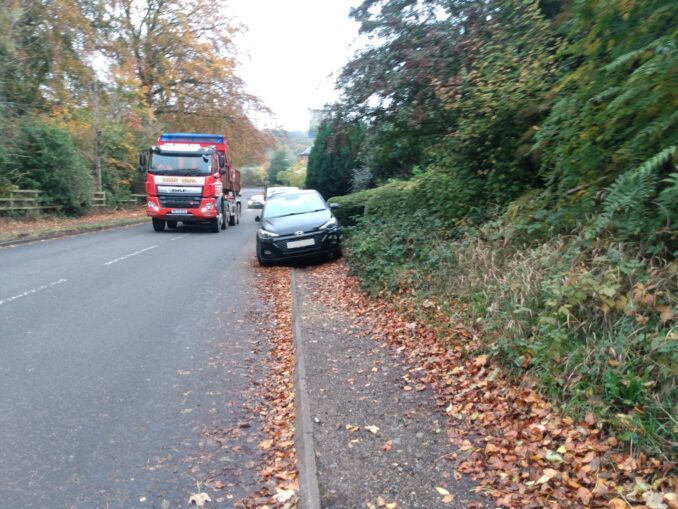
At the end of September a site meeting was held at the top of Lowes Barn Bank with local councillors and officers from the County Council highways department, to listen to the concerns of residents regarding the road conditions on the street. The street always suffers from heavy traffic: along with Potters Bank on the other side of the A167 it forms a convenient short-cut for east-west traffic. With the Burnigill Bank crossing of the railway line on Browney Lane currently closed, there is even more pressure on the street. Heavy goods vehicles (HGVs) are a big concern, especially when they travel fast downhill. Local haulage and construction firms often use the road to access Meadowfield.
Lowes Barn Bank is used by pedestrians and cyclists, especially those travelling to the university or the city centre. As well as practical journeys, it is also used by people who live in the Neville’s Cross and Merryoaks areas to access the popular railway paths at Broom Park. People on bikes either have to take their chance on the road, or ride illegally on the pavement. Cycling in the steep uphill direction, moving out to pass parked cars and experiencing frequent overtaking by motor vehicles, is an uncomfortable experience. Pedestrians do not have it much better: the pavements are poorly maintained. If you are walking on the south side pavement, on the outside of the curve, you can feel particularly vulnerable as heavy vehicles speed past. The pavement on the north side, where most of the houses are, gives up alongside Kipling Terrace. There is a private access path via steps at the bottom of the terrace, but parents pushing buggies have to walk in the road, often round the outside of cars which have been parked on the bank or the pavement. Some residents do not have drives, and it is tempting to get the car off the road to avoid damage by passing vehicles.
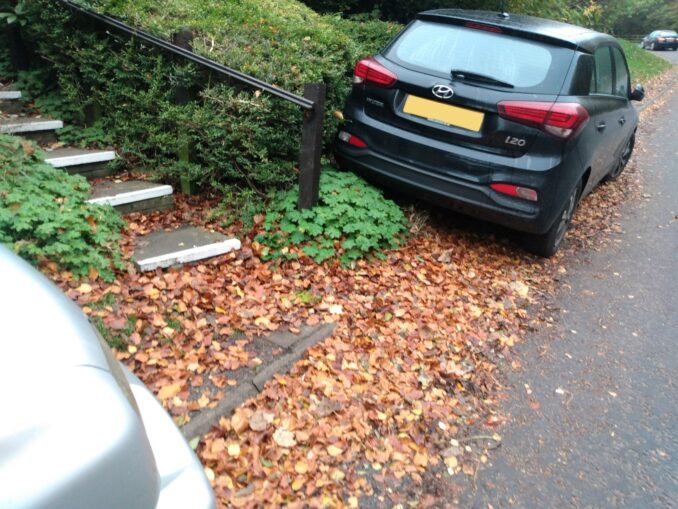
At the meeting the Highways officers offered few solutions. They were not in favour of a 20mph limit or traffic calming. “The parked cars provide some measure of traffic calming”, one officer said. That will not have reassured residents, who say there have been many collisions and near misses. The County Council only takes account of collisions reported to the police. The officers were not keen on applying a weight restriction to divert HGVs, citing the need to maintain access for deliveries to businesses. The view was very much that this was a through road, all the traffic had to be accommodated somehow, and any restriction would just move the problems elsewhere. When challenged as to whether he considered the road to be safe at present, one of the officers said that it met the required specifications for a road of this class and usage. Improving the footways was under consideration, but had not made it into this year’s programme.
Heavy goods
A local resident has provided some analysis of the use of the road. The following graph plots the daily traffic flows against the percentage of HGVs for each B and C road in County Durham. Only three other C roads have a higher daily flow of general traffic. On the HGV traffic, Lowes Barn Bank is extraordinary. Not only is there a higher proportion of HGV traffic than any other road, but it has more than doubled in the last ten years.
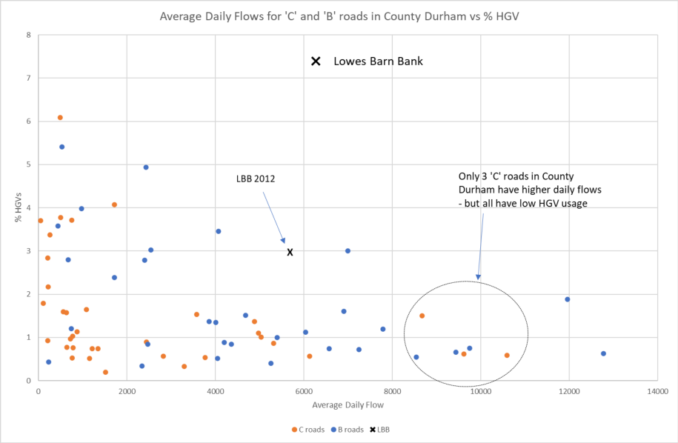
What can be done?
At a minimum, a pavement should be provided all the way along the north side of the road. It appears there is space within the adopted highway land, as can be seen on the Council’s Adopted Highways map. The lack of pavement was noted in Map 8 of the Durham City Neighbourhood Plan, and on page 8 of the Walking and cycling evidence paper which supported preparation of the plan’s transport policies.
Despite representations from SPACE for Durham members, Lowes Barn Bank was not included as either a primary or a secondary cycle route in the Local Cycling and Walking Infrastructure Plan. Neither was Neville’s Cross Bank. It is clear that these roads need safe cycling provision to connect the city with Langley Moor, Meadowfield and Brandon. Councillor Scott told the meeting that the council was considering widening the south side footpath to provide a shared-use route for people walking and cycling. SPACE for Durham is concerned that this would put cyclists speeding downhill in conflict with pedestrians: without pedalling hard it is easy to reach 30mph by the bottom of the hill. Protected uphill cycling space is definitely required, but it might be best for downhill cycling to stay on the road. A 20mph limit for all vehicles would help improve safety if it could be enforced. The Council has rejected a weight restriction, citing the need to service local businesses, but as there are no businesses lining most of the road, this should surely be challenged.
The more radical option for the street would be to make it one-way for motor traffic, at least between the bottom of the road and Hastings Avenue. One-way uphill would be more compatible with parking cars on the north side, by the houses, and would help to reduce the incidence of speeding vehicles. Air quality would be improved if the one-way traffic was downhill, but that would displace the pollution to Neville’s Cross Bank, including the area around the primary school. There may be issues with large vehicles making the left turn from the A167 to go down Neville’s Cross Bank, but there is ample highways space there to remodel the left turn. As one-way streets can tempt drivers to speed, traffic calming measures and a narrowing of the carriageway would probably be necessary.
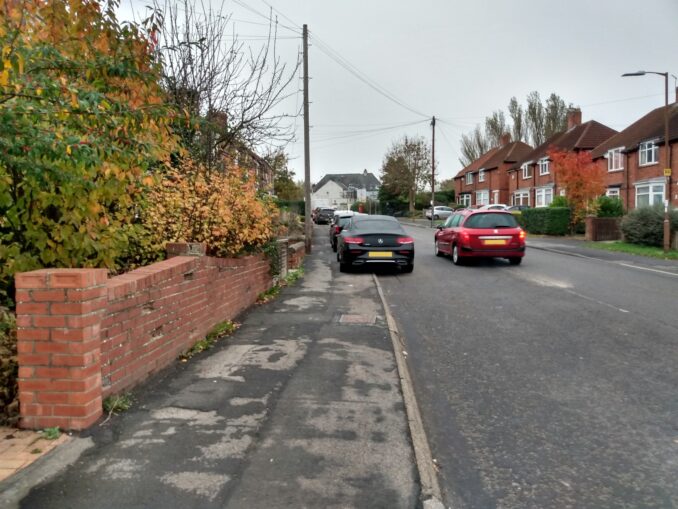
Given that some drivers are parking on the pavement, an alternative option might be to provide kerb build-outs with bollards to create formal parking bays at strategic locations towards the bottom of the bank. This would encourage drivers to keep the pavements free for pedestrians, and when the parking is empty would still calm the traffic. Attention would be required to provide safe uphill cycling space.
Further action
It is clear that the Council is reluctant to take any action, and representations to the police have similarly been unsuccessful. The authorities still have a strong imperative to maintain motor traffic flows, even where this makes it harder to create a safe pedestrian and cycle environment. The Highways department needs to start paying attention to the Climate Emergency Response Plan 2, which has identified the need to reduce motor traffic by 25% in the next two years, unless an unprecedented shift to electric vehicles can be achieved. Restrictions on motor traffic which help to enable more active travel are going to need to be part of the solution. Reducing through traffic on minor roads like Lowes Barn Bank should be part of the strategy.
There is currently a petition to Durham County Council open until 31 December 2022 to ask for mitigation measures, and the local MP, Mary Foy, has called for constituents to send her their thoughts and experiences on the use of the road. We would also be keen to hear your thoughts via the comment form below this message.
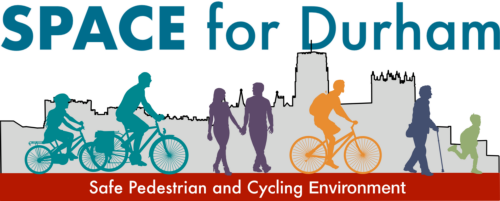
Great read – thanks! Action is long overdue on this road to protect all vulnerable road users from the insane number of lorries on what is a steep and bendy residential ‘c’ road.
Just to add to my previous comment – in the last week, I have seen one near miss between a car and a cyclist on the bend, and one cyclist who was given verbal abuse for “not getting off the f***** road” whilst plodding valiantly away up the hill with a line of cars and lorries behind him….DCC need to wake up and realise this is the ONLY cycle route out of Durham westwards.